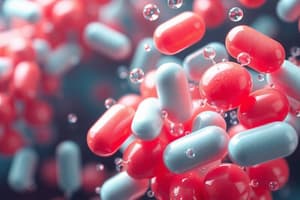Podcast
Questions and Answers
Which of the following antibiotics primarily target gram-positive bacteria?
Which of the following antibiotics primarily target gram-positive bacteria?
- Carbapenems
- Cephalosporins
- Penicillins (correct)
- Monobactams
Beta-lactam antibiotics work by inhibiting which bacterial proteins?
Beta-lactam antibiotics work by inhibiting which bacterial proteins?
- Penicillin-Binding Proteins (PBPs) (correct)
- RNA Polymerase
- DNA Gyrase
- Ribosomal Proteins
Which of the following is NOT a mechanism of bacterial resistance to beta-lactam antibiotics?
Which of the following is NOT a mechanism of bacterial resistance to beta-lactam antibiotics?
- Increased drug permeability (correct)
- Altered PBPs
- Reduced drug permeability
- Beta-lactamase production
Which of the following is a beta-lactamase inhibitor used to protect penicillins from inactivation?
Which of the following is a beta-lactamase inhibitor used to protect penicillins from inactivation?
What is the primary difference between carbapenems and monobactams?
What is the primary difference between carbapenems and monobactams?
Flashcards
Penicillins
Penicillins
Antibiotics effective mainly against gram-positive bacteria.
Cephalosporins
Cephalosporins
Antibiotics derived from Cephalosporium, with multiple generations.
Beta-lactam antibiotics
Beta-lactam antibiotics
Disrupt bacterial cell wall synthesis by inhibiting PBPs.
Beta-Lactamase Inhibitors
Beta-Lactamase Inhibitors
Signup and view all the flashcards
Carbapenems
Carbapenems
Signup and view all the flashcards
Study Notes
Cell Wall Synthesis Inhibitors
- Penicillins: Include Penicillin G, Penicillin V, and Amoxicillin. Primarily effective against Gram-positive bacteria.
- Cephalosporins: Derived from Cephalosporium, with generations ranging from 1st to 5th.
- Carbapenems: Broad-spectrum antibiotics effective against both Gram-positive and Gram-negative bacteria, including Pseudomonas aeruginosa.
- Monobactams: Such as Aztreonam, targeting Gram-negative bacteria like Pseudomonas aeruginosa.
Mechanism of Action
- Beta-lactam antibiotics: Disrupt bacterial cell wall synthesis by inhibiting penicillin-binding proteins (PBPs), leading to bacterial cell lysis.
Bacterial Resistance
- Mechanisms include beta-lactamase activity, alteration of PBPs, and reduced drug permeability.
Beta-Lactamase Inhibitors
- Examples like Clavulanic acid, Sulbactam, and Tazobactam protect penicillins from enzyme inactivation.
Therapeutic Uses
- Penicillins are used for skin and soft tissue infections.
- Cephalosporins are used for respiratory, urinary, and soft tissue infections.
Adverse Effects
- Both penicillins and cephalosporins can cause hypersensitivity reactions and gastrointestinal disturbances.
Carbapenems and Monobactams
- Carbapenems: Potent broad-spectrum antibiotics.
- Monobactams: Like Aztreonam, target Gram-negative bacteria.
Studying That Suits You
Use AI to generate personalized quizzes and flashcards to suit your learning preferences.




